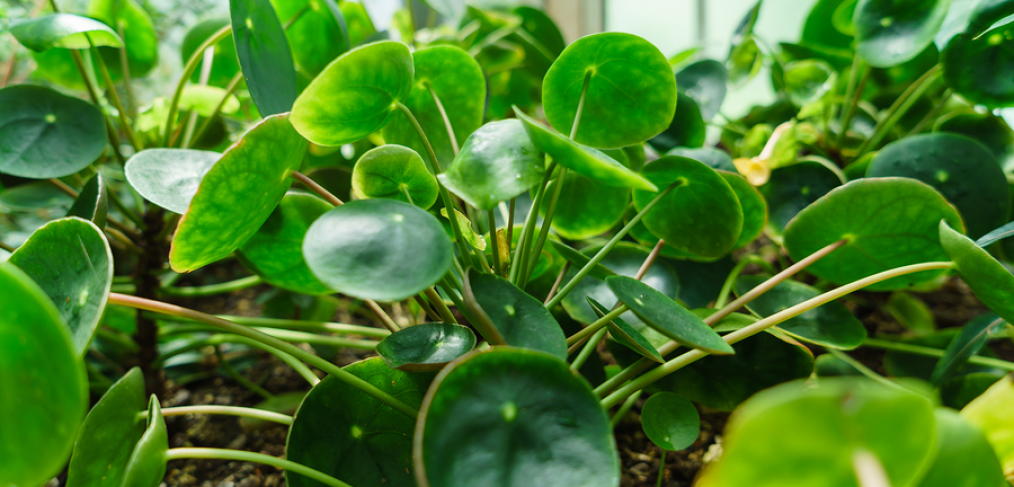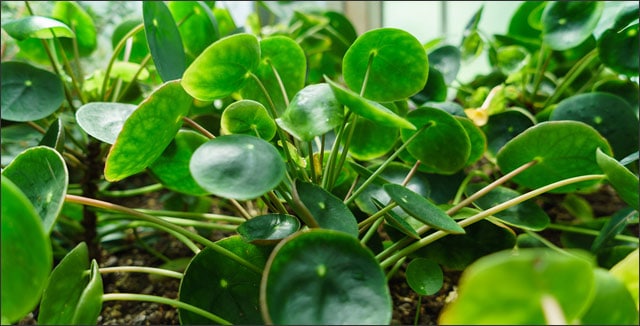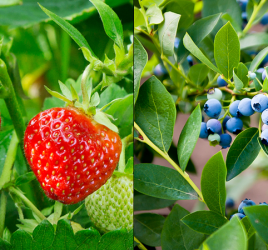
Chinese Money Plants: Elusive Succulents to Share with Friends

Don’t you love the idea of a plant gaining popularity solely through sharing cuttings between friends? Chinese money plants or Pilea Peperomioides started its houseplant journey that way, and it continues to this day.
There are a few places to find this evergreen perennial plant online, but not many. You won’t find one in a nursery because they grow too slowly to be commercially useful.
If you want a Chinese money plant of your very own, your best bet, to this day, is to get a baby plant from a friend.
The History of Chinese Money Plants
Also known as the friendship plant, pancake plant, the missionary plant, or the UFO plant, the Pilea Peperomioides with its round, flat leaves is a native of the Southwestern Yunnan province of China.
This is where a Norwegian missionary by the name of Agnar Espegren found this unusual plant – probably being sold as a potted plant in the market. He brought it with him first to India and then back to Norway in 1946. As he traveled throughout Norway, he gave baby plants to friends.
What is so interesting, though, is how widespread this plant had become throughout the west before it came to the attention of botanists.
After an inquiry made to the Royal Botanic Gardens in England, the story of where the plant came from had to be traced first through Sweden and then to Norway and then eventually back to its Chinese roots.
Botanists used a television commercial in the 1980s to find out who had the plant because they were stumped.
To this day, much that is written about the care of the Pilea plant remains in the hands of amateur gardeners who are growing one on their windowsills.
Caring For Your Chinese Money Plant
As you will find out if you manage to find one of these plant, the Chinese money plant is a happy plant and easy to care for.
Agnar Espegren managed to keep his alive through two continental moves.
Chinese money plants need a combination of proper drainage, regular watering, and bright but indirect light to stay happy.
The plant stays small – only 8 – 12 inches high with leaves that reach about 4 inches in diameter that sprout from a single, central crown. Healthy Chinese money plants can grow dense leaves which will naturally form a beautiful mound shape.
Good Drainage
Choose whatever type of pot you like, but make sure it has drainage holes at the bottom. You don’t want your Chinese money plant sitting in water.
Use well-draining potting soil and let it dry somewhat between watering. Chinese money plants will tell you when they need more water by getting droopy.
Watering
Once a week seems to be what works best for the Chinese money plant, with time in between to make sure it has a chance to dry a bit.
In hotter months, the plant may need more water. If you have plants in terracotta pots, be aware that the pots absorb some of the water too so that it may need more watering.
Light
Chinese money plant leaves will scorch in direct sunlight. However, they need plenty of indirect light to flourish. In more shaded areas, the Pilea will grow broader or darker green leaves.
These plants tend to grow in the direction of the sun, so rotating them every few days will keep this plant looking symmetrical.
One important note: do not place your Chinese money plant near a heater in the cold months. The blowing heat will cause the leaves to fall off, and ultimately, kill the plant.
On the flip side, Chinese money plants are very hardy in the cold – all the way down to freezing temperatures. Colder temperatures may make the plant flower its small white flowers on pink stems.
Propagating Chinese Money Plants
No plant could be easier to share with friends because this plant, like the spider plant, makes its own babies.
New Chinese money plant shoots grow on the stem of the plant. In addition, the shoots pop up through the soil. Plants may put forth shoots both ways or only one way.
Plantlets that pop up through the soil are easy to take and share because they already have roots.
Once they are big enough to grow on their own, transplant and share with a friend. The bigger the plantlet, the better, for the survival of the plant.
Follow the stem about half an inch below the soil and cut it under the dirt with a clean, sharp knife. Put it into moist soil and allow it to get anchored. It will soon start to sprout new leaves of its own.
Plantlets growing from the stem are almost as easy to propagate. Pick a shoot big enough to survive on its own, cut with a clean, sharp knife and put it in water so it will grow some roots.
The process should take about two weeks. When you see little roots emerge, put them into damp soil.
Cuttings are best taken in the spring when the plant is growing swiftly and making the most little “babies.” You can use an all-purpose fertilizer at this time as well.
Where to Find Chinese Money Plants
If you live in Scandinavia, you are in luck. Chinese money plants are very popular there, and you probably know someone who will give you one of their plantlets.
If you live in China, likely, you can also find Pilea Peperomioides easily.
For those of us in the U.S., finding a Chinese money plant in a store could be challenging. You can always take a chance and order one online. Some places sell them (at very high prices) in beautiful, modern pots.
They are known to survive being moved around. You can also look around on social media to find out who has this plant near you. Take a chance and make a new friend!
Takeaway
Chinese money plants are unique-looking, easy to care for, and have an interesting history. If you are looking for a unique and elusive plant for your home or garden, this evergreen succulent is the perfect choice.
Your Turn
Do you own a Chinese money plant? We would love to hear your story on how you acquired one in the comments below.




I have raised plants most of my life and during our 53 years of marriage. We recently moved to the Pacific Northwest to be close to our daughter and grandchildren and I couldn’t bring all my plants (given to friends). Today our daughter, who inherited my love of plants gave me a small Chinese money plant. I have never had one so tonight I am reading up on all I can. Looking forward to a new experience. Wish me Luck!
Just purchased the plant through Amazon.com. First saw one on QVC about two months ago and became intrigued as I never saw this plant before and thought it unique and something I wanted to add to my plant collection. Looking forward to taking care of it and interested in propagating it once I am able.